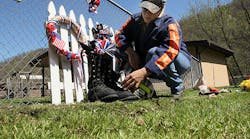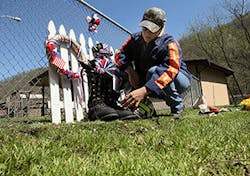You have seen the news. The jury convicted Don Blankenship of conspiracy to willfully violate mandatory federal mine safety and health standards at Upper Big Branch South Mine (UBB).
Such an important case deserves some scrutiny of the details. They are in the federal grand jury indictment.
“Blankenship was fully aware of UBB's practice of routinely violating mandatory federal mine safety standards,” said the indictment. “And in or around April 2009, Blankenship requested and began to receive a report every work day detailing Massey's violations of mandatory federal mine safety standards, including an estimate of the fines that Massey would owe for these violations.”
The indictment went on to state that “on or around July 1, 2009, Blankenship received a safety-violation report for the year through on or around June 30, 2009. This report showed Blankenship that in the first six months of 2009, the UBB group of mines was cited for approximately 596 violations of mandatory federal mine safety and health standards resulting in an estimated $918,401 in fines, more than any other Massey mining group.”
According to the indictment, the report also showed Blankenship that the mandatory federal mine safety standard violated most often at the UBB group of mines was the standard requiring that accumulations of explosive float coal dust, combustible loose coal and other combustible materials be cleaned up and not permitted to accumulate.
The report further showed him that the area of mandatory federal mine safety standards violated most often at Massey's mines as a whole were the standards concerning mine ventilation, which were intended, among other things, to prevent mine explosions and fires and to minimize the risk to miners of death or serious injury if an explosion or fire occurs. In fact, Massey's mines violated mandatory federal mine safety standards on ventilation approximately 1002 times in the first half of 2009.
From approximately April 3, 2009, through April 5, 2010, Blankenship received approximately 249 of these daily safety violation reports and he read them. “Substantially every one of these 249 reports showed Blankenship that the UBB mining group was committing hundreds of safety-law violations every year,”
These allegations and more were the basis for count one: “Conspiracy to Willfully Violate Mandatory Mine Safety and Health Standards.” The jury found him guilty. That is a good start. It should not be the end of the matter.
The Meaning of the Allegations
Blankenship regularly and frequently violated MSHA standards that were intended to prevent mine explosions and fires and to minimize the risk to miners of death or serious injury if an explosion or fire occurs. His utter contempt for and disregard of key safety standards led to the deaths of many miners.
Consequently, this federal case should be the alarm to wake up the West Virginia state sttorney’s office to seek multiple counts of involuntary manslaughter. According to the West Virginia Homicide Jury Instructions Project of Professor James R. Elkins and students at the West Virginia University College of Law (Spring, 2006), the “standard jury instruction” is: “Involuntary manslaughter involves the accidental causing of death of another person, although unintended, which death is the proximate result of negligence so gross, wanton and culpable as to show a reckless disregard for human life.”
West Virginia Criminal Jury Instructions, Sixth Edition, says that involuntary manslaughter is committed when a person, while engaged in an unlawful act, unintentionally causes the death of another, or where a person engaged in a lawful act, unlawfully [and with a reckless disregard of the safety of others] causes the death of another.
How many violations of safety and health regulations (resulting in many deaths) are needed to show reckless disregard for the safety of others?
I expect that a fair jury in West Virginia, given the opportunity, could find Don Blankenship guilty of multiple counts of involuntary manslaughter. It would mean more than a conviction for conspiring to violate some annoying mine safety and health regulations. It would be justice.

